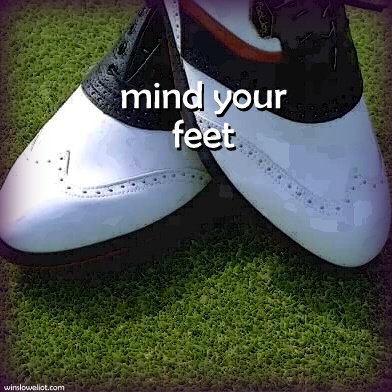
Stillness 6-13: Sometimes your feet may look and feel like remnants of your past, but they’re actually what take you into your future. When you walk, they’re always there, slightly ahead of you, showing you the way. So how do they feel to you? How do they look? How do you dress them and how do you address them?
Do you marvel or loathe or feel grateful? Do they ache? Are you someone who appreciates the loveliness of shoes? Do you enjoy them? Do you smile at your toes? Or do you keep them snug in sleeping-bag-like running shoes, protected and snug, out of harm’s way?
One of my favorite stillness practices is to live into my feet. I do this by first becoming mindful of them, then massaging, moisturizing, talking to them, and then meditating on them. My experience is that this somewhat peculiar practice helps to center and balance me, from the ground up. Afterward, I feel stronger, more empowered, and more capable of taking whatever might be my next steps into my future. Also, I feel clearer about where I need to go.
Our feet are an intricate web of muscles and bones that serve us all day, every day. Their beautiful shape works in tandem with our sense of balance to enable us to walk, run, skip, climb, and to pick things up with our toes. Structurally, they’re tremendously strong. They’re also flexible and incredibly complex, with more than 100 tendons, ligaments, and muscles that move dozens of joints. People who have lost the use of their hands can learn to be equally dexterous with their feet.
I love the names of the bones in our feet—some of them are like the names of mythological heroes in legends of old. Calcaneus is the largest one. Then there’s Tibia, Fibula, Talus. And what’s the story behind Cuneiform, Cuboid, and Navicular? These heroes and heroines move along three undulating and flexible arches that help us walk in a rhythmic flow that harmonizes with our whole body. Everything in our bodies is connected to each other in some way, and so every part of our feet corresponds to other parts of our body, just as our head and hands do. A foot reflexologist applies pressure to specific reflex points on the foot that correspond to organs or muscles to alleviate symptoms of pain and stress. You can do this for yourself, even if you don’t know the specifics of the correspondences. You’ll find even a brief, gentle foot massage helps you become calmer, more energetic, and more peaceful.
Your feet take you where you have to go. Trust them. Feel gratitude for them and treat them as you would your dearest friends or staunchest allies. Your feet are what you stand on, what support you, what you rely on to propel you forward. Take some time today to appreciate them. Grow mindful of them. Ask them to help guide you to where you have to go.
